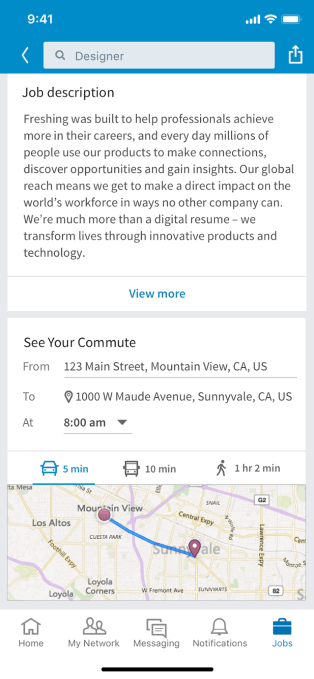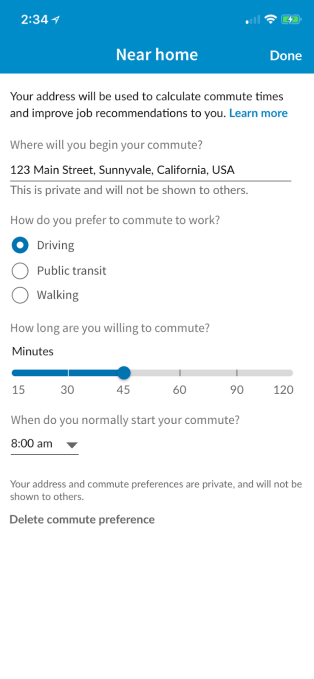LinkedIn debuts Your Commute, navigation and maps to evaluate jobs based on how far they are [TechCrunch]

LinkedIn, the social media site that’s aimed at people looking to network or otherwise change up their career prospects, is taking a plunge into location-based services. From today, the company is turning on a new feature that will let job-seekers check out the location and commute time to specific businesses, to help them evaluate whether they would want to work there.
‘Your Commute’ as the feature is called, is now available globally on mobile, providing location data for all businesses where LinkedIn already has location information, and it will be coming soon to desktop, senior product manager Dan Li told TechCrunch.
 The feature will appear within job postings on LinkedIn and will become a part of how LinkedIn surfaces job opportunities in its search feature for its 500 million-plus users. “When members save their location preferences in Career Interests, we’re able to provide more relevant job recommendations that fit exactly what they’re looking for in their next role,” he said. “We’re thinking through additional ways members can use location information to improve their job searches in the near future.”
The feature will appear within job postings on LinkedIn and will become a part of how LinkedIn surfaces job opportunities in its search feature for its 500 million-plus users. “When members save their location preferences in Career Interests, we’re able to provide more relevant job recommendations that fit exactly what they’re looking for in their next role,” he said. “We’re thinking through additional ways members can use location information to improve their job searches in the near future.”
For now, the distance feature isn’t being used in other parts of the LinkedIn platform, but you can imagine where it might pop up next. For example, when two contacts are arranging an in-person meeting, LinkedIn’s AI ‘bot’ — which is already being used to suggest conversation openers in messages — could suggest locations to meet that are mutually convenient for the two parties.
LinkedIn, which was acquired by Microsoft for $26.2 billion in 2016, has been slowly cross-pollenating features and services with its new owner, and this is the case here. The location and navigation data is being supplied by Bing Maps, Microsoft’s mapping service that is akin to Google and Apple Maps, by way of its API.
Using it in LinkedIn will give Bing one more extension into more traffic and data collection to help expand the maps’ datasets. And for a mapping service that lags by some way behind use of Google Maps, that extra boost is a help. For LinkedIn, it gives it one more hook to keep people engaged in and using their service, both to expand the usefulness of LinkedIn itself, as well as to give its job listings one more edge over other competing job boards.
You can get an initial list of details about a company’s location through LinkedIn itself — helping with the app’s own engagement — but LinkedIn, hoping to make this as useful as possible, will also allow users to dive in deeper and open the navigation up in other maps.
 While LinkedIn has sometimes been taken to task for how it suggests connections to users — particularly in cases where it isn’t even clear how LinkedIn has gleaning is social graph information in the first place — Li said that the addition of this feature came straight from user feedback.
While LinkedIn has sometimes been taken to task for how it suggests connections to users — particularly in cases where it isn’t even clear how LinkedIn has gleaning is social graph information in the first place — Li said that the addition of this feature came straight from user feedback.
“Our members have indicated that the location of a job — and the commute time associated with it — is a big factor in their decision making process when considering new roles, and we know commute times are getting longer across the board according to recent research from Gallup,” he said.
The company’s own LinkedIn survey data indicated that 85 percent of professionals would take a pay cut for a shorter commute. “The Your Commute feature is a quick and easy way for members to access insight into their potential commute directly within the job posting on LinkedIn and empower them to make more informed career decisions.”
More generally, location has become a huge factor in how people choose jobs, and for the less sexy companies out there based in far-flung suburbs that might mean cheaper overheads, it’s become a false economy of sorts, as these same companies have found their locations to be a challenge when recruiting talent. Some have even opted to lease spaces in WeWork offices or other slick co-working venues that are in more central areas, as a way of attracting top candidates.
The more complicated side of that has seen huge concentrations of people in specific industries like the tech world, where remunerations are generous, flocking and filling out cities across the Bay Area to be closer to their jobs, leading to huge housing crunches. In a way, LinkedIn’s tool could make that location drive even more acute in sectors where it’s already a problem.
Source: TechCrunch https://techcrunch.com/2018/06/07/linkedin-debuts-your-commute-navigation-and-maps-to-size-up-jobs-based-on-how-far-they-are/

Post a Comment